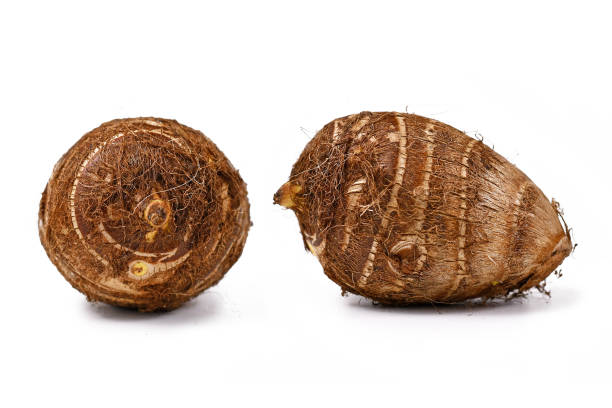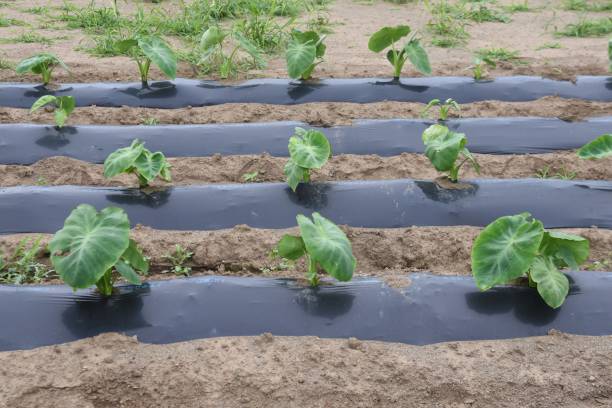

Colocasia esculenta (L.) Schott
|
It is commonly known as Taro and also as Arbi. It belongs to the family Araceae. Both tuber and leaves are consumed as vegetable. It contains the bioactive markers like - phylloquinone, Tarin, α-carotene, α-Tocopherol, β-cryptoxanthin, Lycopene. Hemagglutinin of taro at 0.893 μM upregulated expression of cytokines including IL1-β, IL-2, IFN-γ and TNF-α. Mode of Consumption : Boiled, fried and cooked |
| Plant Details | Agro-climatic Zone | Vernacular Names | Pictures |
| Scientific Name: Colocasia esculenta (L.) Schott Family: Araceae Juss. Class: Magnoliopsida Order: Alismatales Genus: Colocasia Schott Fruiting Season: July-October Parts: Corm, Tender leaves |
|
Andhra Pradesh : Chamadumpa, Chemagadda Assam : Kochu, Thaso, Thaso gwswm Bihar : Arvi, Kachalu, Ghuiya Karnataka : Kachchi, Shamagadde Kerala : Shembu Maharashtra : Alu Odisha : Saru Tamil Nadu : Seppan-kizangun Uttar Pradesh : Arvi West bengal : Kachu |
 Corm  Plant |
| Compound/Extract | Activity | Mode of Action | Marker/References |
| Water-soluble extract | Antimetastatic | Water-soluble extract of taro completely blocked tumor cell migration. The extract also inhibited prostaglandin E2 (PGE2) synthesis and downregulated cyclooxygenase (COX) 1 and 2 mRNA expression. | PGE2, COX-1, COX-2[1] |
| Tarin | Immunomodulatory | In a murine model, tarin stimulated the in vitro and in vivo proliferation of total spleen and bone marrow cells, especially B lymphocytes. | [2] |
| Tarin | Immunomodulatory | Tarin decreased leukopenia in immunosuppressed mice. Promoted repopulation of Bone marrow granulocytic Gr1+ cells. | [3] |
| Hemagglutinin | Immunomodulatory | Taro hemagglutinin (concentration of 0.893 μM) increased expression of cytokines including IL1-β, IL-2, IFN-γ and TNF-α. | IL1-β, IL-2, IFN-γ and TNF-α[4] |
| Tarin | Anti-tumor | Liposomal tarin nanocapsules inhibited breast cancer cell proliferation, with IC50 of 71.38 µg/mL. | [6] |
| Polysaccharide | Antimetastatic | Isolated polysaccharide inhibited the lung metastasis of B16-BL6 melanoma cells. | [7] |
| Major Class | Metabolites (Content of bioactives: mg/100g Fresh Weight) |
| Alkaloid | Caffeine: [8] |
| Amides | Allantoin: [2] |
| Amino Acid | Arginine: 220 mg/100g, Cystine: 64 mg/100g, Histidine: 114 mg/100g, Isoleucine: 260 g/100g, Leucine: 392 mg/100g, Lysine: 246 mg/100g, Methionine: 79 mg/100g, Phenylalanine: 195 mg/100g, Threonine: 167 mg/100g, Tryptophan: 48 mg/100g, Tyrosine: 178 mg/100g, Valine: 256 mg/100g[8] |
| Carotenoid | Lutein: , Lycopene: , Zeaxanthin: , α-Carotene: , β-Carotene: 2.9 mg/100g, β-Cryptoxanthin: [8] |
| Organophosphorus Compounds | Tarin: [2] |
| Steroids | Diosgenin: [3] |
| Vitamin | Ascorbic acid (Shoot): 52 mg/100g, Phylloquinone: 0.109 mg/100g, α-Tocopherol: 2.38 mg/100g[8] |
| Effect | Observation | DOI |
| Disease | Formulation | Reference | Author | TKDL |
| Information from Wealth of India | Reference |
|
CSIR(1950).The Wealth of India, Raw materials,Vol.-II ,P.310-312, New Delhi, India |
| 4.2, 4.2.1, 4.2.1.1, 4.2.1.3, 4.2.2.8 |
| CSIR-North East Institute of Science and Technology, Jorhat-6, Assam, India
CSIR-Institute of Himalayan Bioresource Technology, Palampur-61,Himachal Pradesh, India |